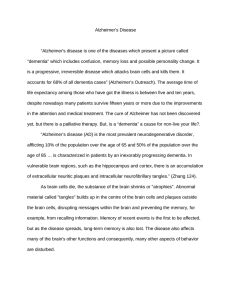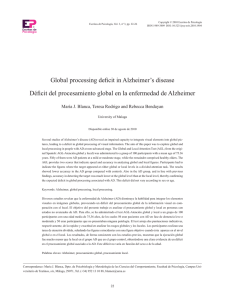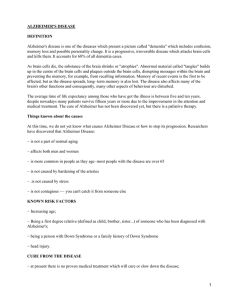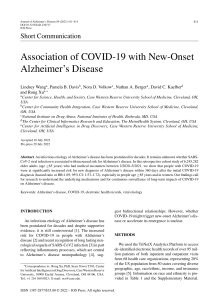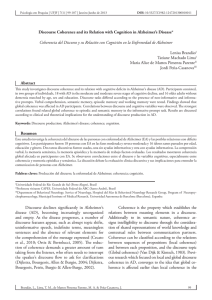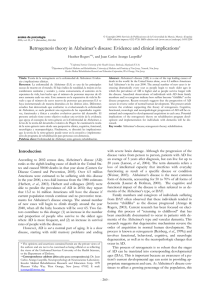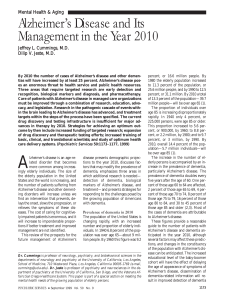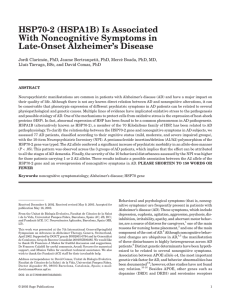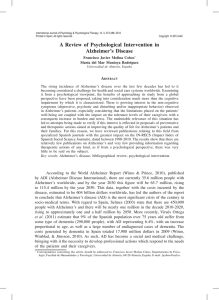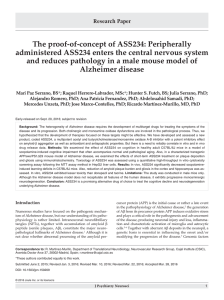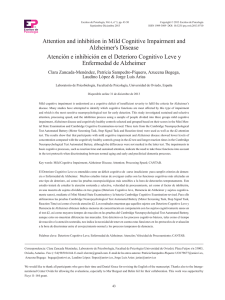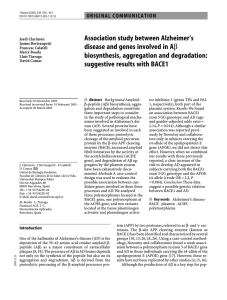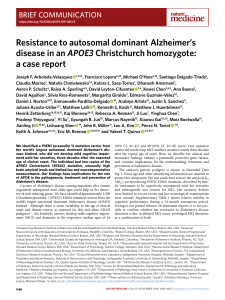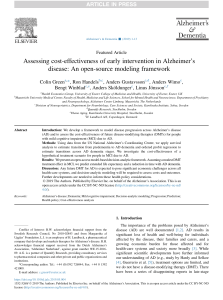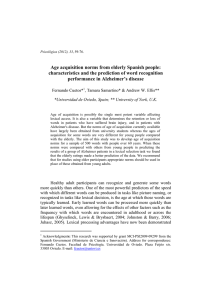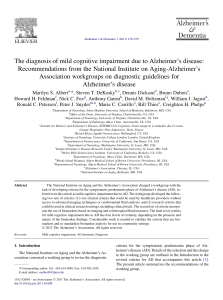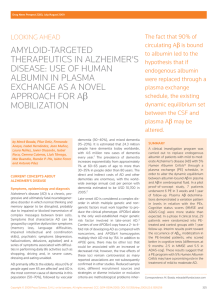visual symptoms as the first manifestation of alzheimer`s disease
Anuncio
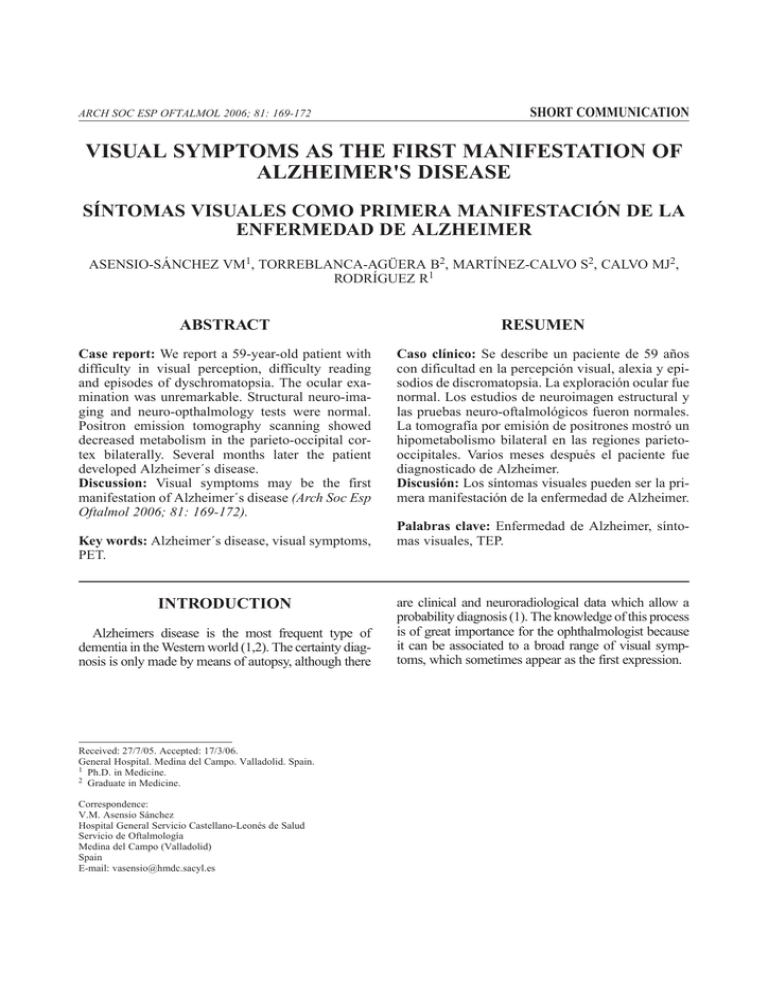
ARCH SOC ESP OFTALMOL 2006; 81: 169-172 SHORT COMMUNICATION VISUAL SYMPTOMS AS THE FIRST MANIFESTATION OF ALZHEIMER'S DISEASE SÍNTOMAS VISUALES COMO PRIMERA MANIFESTACIÓN DE LA ENFERMEDAD DE ALZHEIMER ASENSIO-SÁNCHEZ VM1, TORREBLANCA-AGÜERA B2, MARTÍNEZ-CALVO S2, CALVO MJ2, RODRÍGUEZ R1 ABSTRACT RESUMEN Case report: We report a 59-year-old patient with difficulty in visual perception, difficulty reading and episodes of dyschromatopsia. The ocular examination was unremarkable. Structural neuro-imaging and neuro-opthalmology tests were normal. Positron emission tomography scanning showed decreased metabolism in the parieto-occipital cortex bilaterally. Several months later the patient developed Alzheimer´s disease. Discussion: Visual symptoms may be the first manifestation of Alzheimer´s disease (Arch Soc Esp Oftalmol 2006; 81: 169-172). Caso clínico: Se describe un paciente de 59 años con dificultad en la percepción visual, alexia y episodios de discromatopsia. La exploración ocular fue normal. Los estudios de neuroimagen estructural y las pruebas neuro-oftalmológicos fueron normales. La tomografía por emisión de positrones mostró un hipometabolismo bilateral en las regiones parietooccipitales. Varios meses después el paciente fue diagnosticado de Alzheimer. Discusión: Los síntomas visuales pueden ser la primera manifestación de la enfermedad de Alzheimer. Key words: Alzheimer´s disease, visual symptoms, PET. INTRODUCTION Alzheimers disease is the most frequent type of dementia in the Western world (1,2). The certainty diagnosis is only made by means of autopsy, although there Received: 27/7/05. Accepted: 17/3/06. General Hospital. Medina del Campo. Valladolid. Spain. 1 Ph.D. in Medicine. 2 Graduate in Medicine. Correspondence: V.M. Asensio Sánchez Hospital General Servicio Castellano-Leonés de Salud Servicio de Oftalmología Medina del Campo (Valladolid) Spain E-mail: [email protected] Palabras clave: Enfermedad de Alzheimer, síntomas visuales, TEP. are clinical and neuroradiological data which allow a probability diagnosis (1). The knowledge of this process is of great importance for the ophthalmologist because it can be associated to a broad range of visual symptoms, which sometimes appear as the first expression. ASENSIO-SÁNCHEZ VM, et al. CLINICAL CASE A 59 year-old man who, in December 2003, was referred to the external practise by his primary care physician due to a suspected macular problem. The patient described "difficulties in perceiving objects, with double vision of straight lines, difficulty for reading and on some occasions black and white vision". The patient’s systemic history was not relevant and he was not in treatment with medication. Maximum visual acuity in the right eye was of 0.8 and of 1 in the left eye. Applanation eye pressure was 18 mmHg in both eyes. The exploration of the anterior and posterior poles was normal. The visual field (Octopus G1X) and the colour tests gave normal results for both eyes. The ERG (UTAS-E 3000, LKC Technologies Inc., Gaithesburg, MD, USA) yielded low amplitude potentials in the left eye and latencies within normal limits in both eyes. The PEV’s were compatible with normality. Due to the persistence of the symptoms, a Magnetic Nuclear Resonance was carried out in February 2004 for the brain and orbital region which did not identify any pathology (fig. 1). In April 2004 a positron emission tomography (PET) scan revealed parietal-occipital bilateral hypo-metabolism (fig. 2). A diagnosis of probable Alzheimer's disease was given. In October 2004, the patient had difficulties for reading, writing and didn't feel confident to drive. In January 2005, complex visual and spatial alterations were evident: the patient perceived the room rotated and people walking on the walls (alesthesia) and referred difficulties in perceiving movement (akinetopsy), loss of memory, personality changes and relaxation of sphincters. In May 2005, he was Fig. 1: MNR-T2 (February, 2004) normal. 170 Fig. 2: Positron emission tomography (FDG-PET) axial section at the level of the third ventricule (April 2004), showing bilateral hypometabolism in the parietal-occipital regions. The yellowish colour represents the absorption of glucose. The yellow and red represents normal metabolism. Blue and purple indicates low absorption, consistent with hypometabolism. admitted for a bronchial and pulmonary aspiration which presented multiple organ complications which caused his death 20 days later. Autopsy could not be performed because the family did not authorise it. DISCUSSION Alzheimers disease is the most frequent type of dementia in the Western world, accounting for two thirds of all diagnosied dementia after 65 years of age (1,2). This pathology is of great interest for the ophthalmologist because it is a process which usually affects people over 65 who on many occasions exhibit visual symptoms which, as in the case in discussion, can precede systemic symptoms (1,2). Of all clinical expressions of Alzheimer's, the least known and least described in literature is that which begins with (and develops) posterior cortex involvement (3). The patient described above exhibited simultagnosia, alexia and discromatopsy, all of these complex visual functions which require perfect coordination of the upper centres, without any systemic or analytical data which may point to Alzheimer. Exploration of the eye was normal, just as NMR, but PET showed hypometabolism of the occipital regions. Lee et al (2) described 8 patients with a visual variant of Alzheimer's and none had a ARCH SOC ESP OFTALMOL 2006; 81: 169-172 Alzheimer's disease diagnosis made by an ophthalmologist. The neuroradiological study was normal in two patients, while six exhibited parietal and/or cortical atrophy. The PET performed in five cases showed a hypometabolism in both parietal-occipital regions. Some patients (Alzheimer's visual variant) exhibited prominent visual symptoms and in these cases there is a greater atrophy of the temporal and occipital lobes than in patients with a typical form of Alzheimer (2). The visual alteration in Alzheimer's is caused by neuropathology at the level of the primary visual cortex and visual association areas more than to changes at the retinal or optic nerve level. The symptoms described by our patient match the results of PET. There is MRI evidence that V3 and V5 (MT) are two areas which are involved in the perception of movement and are located in the hypometabolism regions evidenced by the PET scan. However, the adjacent area V4 is involved in selective attention, and lesions in this area may explain the alteration of perception and black and white vision episodes. In these cases, visual acuity is usually normal and the eye structure does not exhibit any pathology (1-3). For this reason, it is important for the ophthalmologist to take into account that visual symptoms can be the first expression of Alzheimer's and can precede memory alterations, and therefore it is particularly important to obtain an early diagnosis of a pathology that is on the increase and will allow the patient to benefit from new treatments. In patients such as the one described in this case, with normal ophthalmological exploration and structural radiological studies, functional image tests (PET) may assist in clarifying the diagnosis. REFERENCES 1. Holroyd S, Shepherd ML. Alzheimer´s disease: a review for the ophthalmologist. Surv Ophthalmol 2001; 45: 516524. 2. Lee AG, Matin CO. Neuro-ophthalmic findings in the visual variant of Alzheimer´s disease. Ophthalmology 2004; 111: 376-381. 3. Zarranz JJ, Lasa A, Fernandez M, Lezcano E, Perez Bas M, Varona L, et al. Atrofia cortical posterior con agnosia visual progresiva. Neurologia 1995; 10: 119-126. ARCH SOC ESP OFTALMOL 2006; 81: 169-172 171

